Icom IC-7300 is the first direct sampling SDR (software defined radio) available from one of the “big three” japanese manufacturers. This helps it bring a whole new level of performance at an accesible price point, a much more flexible configuration and a set of features only seen in top-of-the line equipment. Real-time panadapter or fully customizable filters are just the tip of the iceberg.
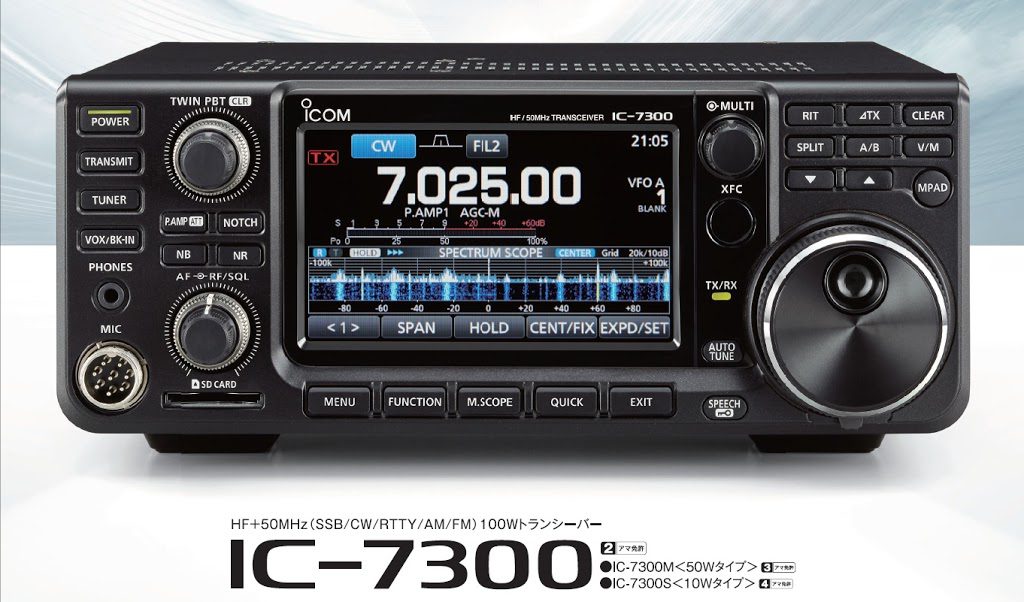
Sure, amateur equipment has been using for a long time various levels of digital signal processing (DSP), but usually this was done in the last part of the receive chain, where it mostly impacted audio quality and not receiver performance. Moving to a direct-sampling SDR architecture means the signal coming from the antenna is directly transposed to the digital domain and instead of all the previously familiar receiver stages (such as mixers, filters, demodulators etc) we are using mathematical formulas applied to the data stream. The advantage of this approach is it eliminates all problems related to real-world hardware receivers (noise, distorsion, losses, imperfections, limitations etc) and opens up a new world on how you can use or visualize RF signals. Goodbye unwanted mixing products, AGC non-linearity, IF chain IMD or filter blow-by. You want a 200Hz to 2250Hz SSB filter ? Just go into the menu, customize it to that value and see how that carrier at 2260Hz simply doesn’t get trough; yes, filter width and shape is just a matter of settings, leaving it all to mathematics to carry it out. Basically, the only part that limits the receiver performance is the Analog-Digital Converter (ADC) that samples the RF signal, and those are already very good.
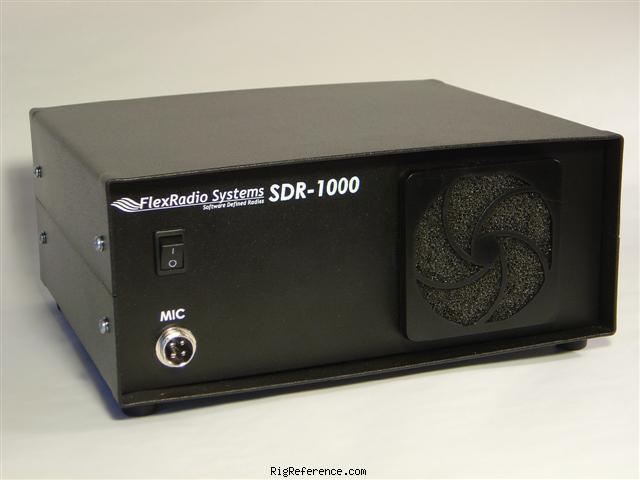
SDR is not a new concept, it has it’s roots back in the 1970’s, in the 90’s it became viable and the military started using it and in the early 2000’s Flexradio started selling the first amateur radio transceivers based on SDR. Although being already at the 3rd generation of SDR radios, Flexradio and other similar manufacturers took a different route, their equipment (historically in the highest performance class) requiring a PC for interfacing and for some level of signal processing. It’s only in 2015 that both Flexradio and SunSDR started offering classic interfaces with their SDR radios, making a step into the mainstream legacy-radio market dominated by Icom, Yaesu and Kenwood. And Icom responded, with the IC-7300.
| Frequency coverage | 0.030–74.800* |
| Mode | SSB, CW, RTTY, AM, FM |
| Number of channels | 101 (99 regular, 2 scan edges) |
| Antenna connector | SO-239 (50Ω) |
| Power supply requirement | 13.8V DC ±15% |
| Power Consumption | Tx: 21A (at 100W output power) Rx: 0.9A typical (standby), 1.25A (Max audio) |
| Operating temperature range | –10˚C to +60˚C; 14˚F to 140˚F |
| Frequency stability | Better than ±0.5ppm (–10˚C to +60˚C; 14˚F to 140˚F) |
| Frequency resolution | 1Hz |
| Dimensions | 240×94×238mm; 9.45×3.7×9.37in |
| Weight | 4.2kg; 9.26 lb (approximately) |
| Transmitter output power | 100W on HF/50MHz, 50W on 70MHz |
| Tuner matching SWR range | 3:1 full power, 10:1 emergency mode (50% power) |
*RX only. TX is restricted to amateur bands, but it can be unlocked for full coverage
SPECS
Technical specifications look pretty normal so far, but you can already see there are a few things that stand out. One would be the continuous RX coverage from 30KHz to 74.8MHz (TX can be unlocked for almost the whole range as well), wich is pretty unusual (and a nice surprise). The other would be the 900mA standby current draw, wich is one of the lowest you can see for a modern radio – certainly the lowest of the Icom IC-7xxx series. Considering all the processsing power inside it and the large display, this is actually almost hard to believe. Finally, the tuner’s 10:1 range is also probably an industry first as integrated tuners usually are limited to a 3:1 SWR matching range.
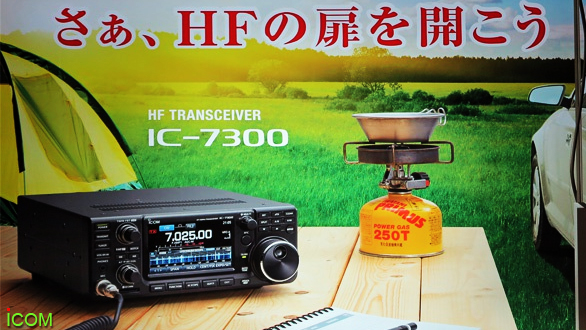
FEATURES
- Class Leading Real-Time Spectrum Scope
- High-Resolution Waterfall Function
- Audio Scope Function
- RF Direct Sampling System
- New “IP+” Function
- Class Leading RMDR (Reciprocal Mixing Dynamic Range) and Phase Noise Characteristics
- Large Touch Screen Colour TFT LCD
- Multi-Dial Knob for Smooth Operation
- SD Memory Card Slot for Saving Data
- 15 Discrete Band-Pass Filters
- Built-In Automatic Antenna Tuner
- Superior Sound Quality
- New HM-219 hand microphone supplied
- Effective large cooling fan system
- A Multi-function meter
- 101 memory channels (99 regular, 2 scan edges)
- Optional RS-BA1 IP remote control software (the spectrum scope with the waterfall can be observed)
- CW functions: Full break-in, CW reverse, CW auto tuning
The feature list is really where this radio should impress most people. The real-time spectrum scope is … real-time, the refresh rate is 30Hz and can display up to 1MHz of bandwidth with an 80dB vertical span. It can be zoomed in, it can be expanded to cover most of the screen, has a very useful waterfall, you can touch a signal on the screen and the radio tunes to it. It is probably the best you can find in a standalone transceiver outside Flex Maestro or SunSDR MB-1 (solutions wich cost 3-5 times more), and I’m including here all the latest or greatest radios out there (IC-7851, Kenwood TS-990, Yaesu FTdx-3000 etc). The quality of the display is pretty good as well, nice colors and good viewing angles, considerably better than the FT-991.
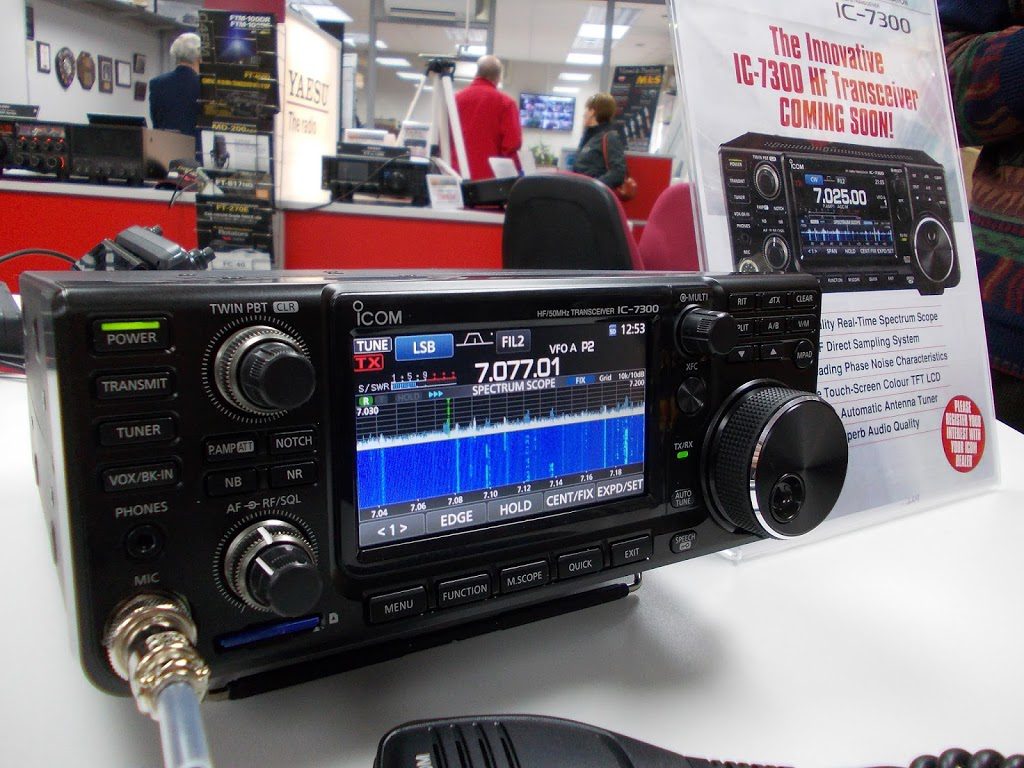
The user interface is very good for such a small radio thanks to the large touchscreen and the thought put behind it: if in a much larger radio (such as the Yaesu FTdx-5000) you have most of the important functions just 1-2 button presses away, in the IC-7300 they are 1-2 touches away. You want to change the band ? Just touch the frequency display on the screen and a band selection screen will temporarily appear. No need to have 12 band buttons that clutter the frontpanel all the time while you only change bands a few times per day. It can also be configurated in a multitude of ways to show wichever information you need at that moment; I liked the possibility to see the audio scope and audio band analyzer, wich could show you if the incoming or transmitted signal includes noise, distorsions, etc – extremely useful for digital modes or when adjusting a new microphone, for example.
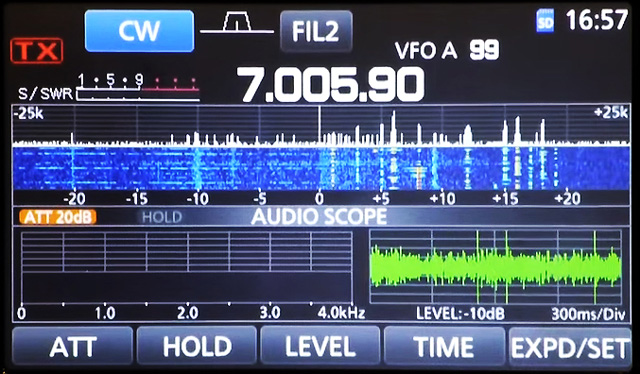
Speaking of a new microphone, the IC-7300 ships with the new HM-219. It’s a basic electret microphone with up/down buttons, but the Icom IC-7300 is such a nice radio it deserved a new model. It feels kind of small in my big hands, but most of the microphone’s merit is in the way it sounds and I need to be on the other end of an IC-7300 to find that out.
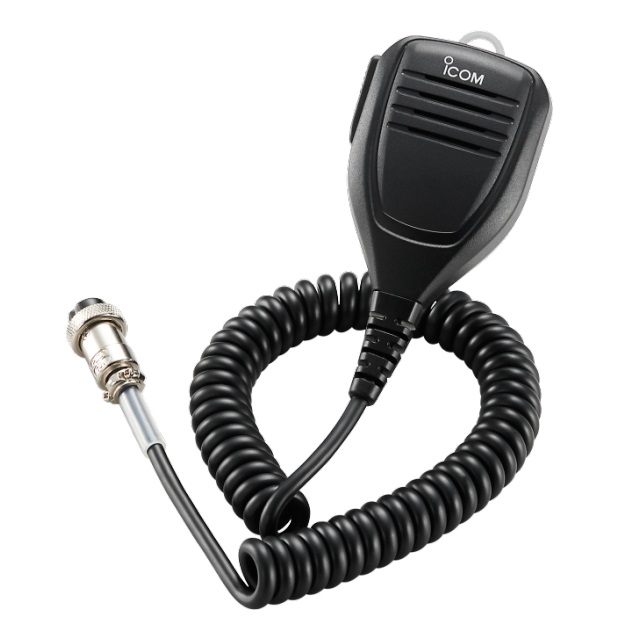
The SD card slot is really useful – it can store audio messages (like different CQ’s or calls for a long-lasting pileup), you can record hours of operating or even add firmware updates on it. Nothing new, but it’s nice to see them in this price range.
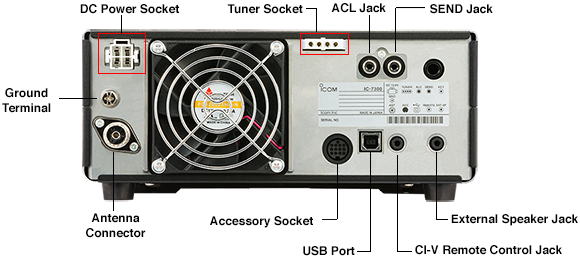
The features that maybe didn’t get enough attention so far are the ones related to the USB port: not only it supports CAT control without the need of an interface, but it also supports audio streaming without the need of an interface. And, it also sends the spectrum data to the computer so you can view it on a large screen with their (not free) Icom RS-BA1 software. And, it sends RTTY decodes to the computer as well. Again, just one USB cable connected to the computer for all that, no need for a separate interface either. Classy !
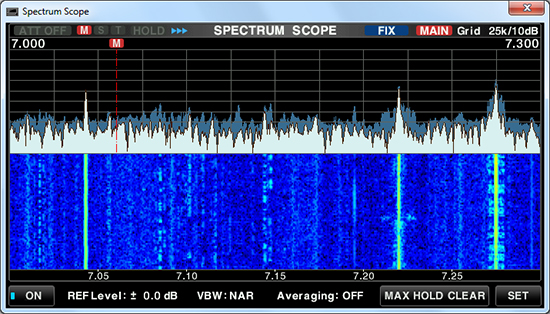
Not trying to avoid the elephant in the room, but trying to clear the room first: the direct sampling technology in the IC-7300 makes excellent performance affordable. The Reciprocal Mixing Dynamic Range (RMDR) is currently the best metric for HF radio performance – the higher the number, the better a receiver could still distinguish a small signal while a very strong signal is present very close in frequency. Icom reports a typical figure for RMDR at 97dB/1KHz spacing. To get an idea how this fares agains what else is out there, similar-priced recent transceivers have been measured by QST at 75dB (Yaesu FT-991), 81dB (Yaesu FTdx-1200), 84dB (Icom IC-7100), 94dB (Kenwood TS-590SG). As expected, the more expensive SDR transceivers have higher figures to show: the Apache Labs ANAN-100D was measured at 105dB and the Flexradio FLEX-6700 116dB. If things didn’t already look very good already, QST measures at 2KHz spacing, where probably IC-7300 hits the 3-figure mark.
ARCHITECTURE
Getting down to the real deal, I’m sure alot of people are interested what did Icom use to replace all the mixers, filters, BFOs, VFOs, VGAs, etc.

First of all, the signal coming from the antenna is preselected via a bank of 15 band-pass filters wich are not designed specifically around amateur bands, so the radio can properly work for general coverage. The filtering is done in order to protect the ADC from overloading with unnecessary out-of-band signals, as well as to eliminate aliased signals. Then, the signal is passed trough a gain stage (-10dB to +20dB) that uses a 2SC3356 preamplifier or an attenuator, and then the SDR begins.
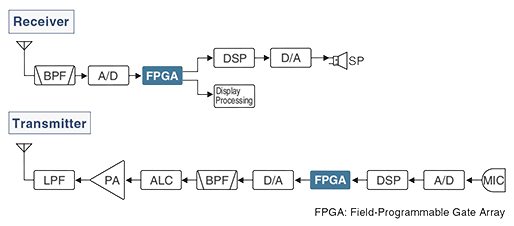
To convert the RF signal to a digital stream of data, the Icom IC-7300 uses a high-performance Analog-Digital Converter (ADC). This is the key component for a SDR’s receiver performance, it’s characteristics directly affecting sensitivity or dynamic range. Although unconfirmed by Icom, apparently they use in the IC-7300 the 14bit Linear Technology LTC2208-14, sampling at ~124Msps. This is not a new part (actually, it’s 9 years old) but it’s good enough and it has been used before in SDR equipment for amateurs, although most opt for the higher-spec LTC2208 16-bit version. The performance difference between the 14bit and 16bit versions is not that large, ~1-2dB worse noise and dynamic range in the datasheet.
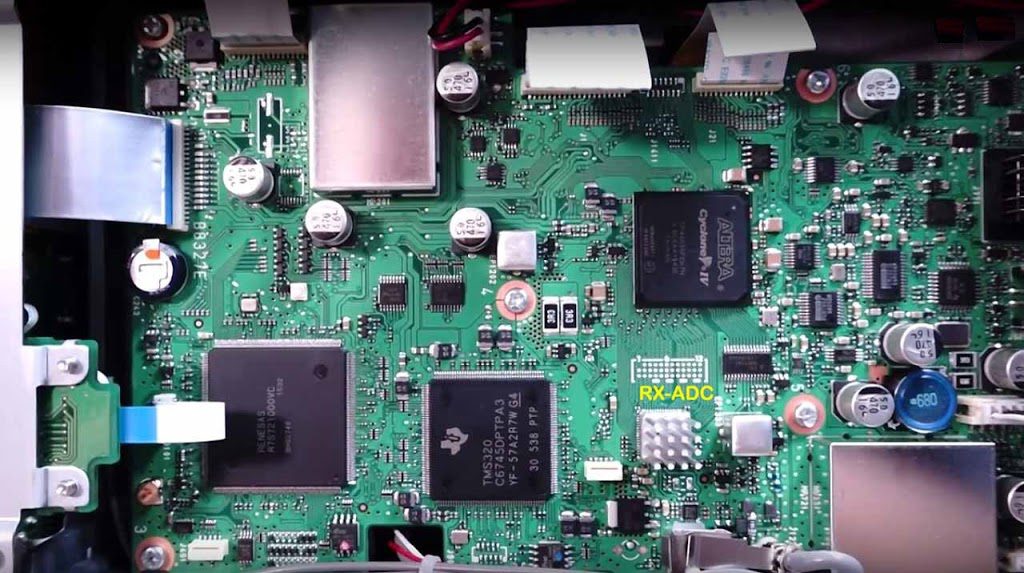
The huge resulted datastream is then passed on to a Field Programmable Gate Array (FPGA), wich is basically an application-specific processor that can be configured on the fly. Being application-specific means it can perform a high-load of complicated tasks with a low power consumption as long as those tasks are what it’s been programmed to do. This is where most of our radio lives now – a few logic units of the FPGA are a mixer, some others are a filter, etc. The more logic units and processing power an FPGA has, the more information it can process. Icom IC-7300 uses an Altera Cyclone IV FPGA with 55k logic units, wich is more than enough for all the radio tasks as well as the 1MHz wide spectrum display. For comparison, the Apache Labs ANAN-100 uses a 40k logic units version of the Cyclone IV, and that is enough for 16-bit ADC stream and 2 independent receivers, each with a 1.152MHz wide spectrum.
| SDR Radios | Icom IC-7300 | Apache Labs ANAN-100 | Flexradio FLEX-6700 |
|---|---|---|---|
| ADC | LTC2208-14 | LTC2208 | AD9467 |
| ADC Resolution | 14 bit | 16 bit | 16 bit |
| ADC Sampling Rate | 124 Msps | 122.88 Msps | 245.76 Msps |
| FPGA | Altera Cyclone IV EP4CE55 | Altera Cyclone IV EP4CE40 | Xilinx Virtex-6 XC6VLX130T |
| FPGA Logic Elements | 55k | 40k | 130k |
| DSP | TMS320C6745 | - | TMS320C6A8167 |
| DSP Computing Power | 2.25 GLOPS | - | 9 GFLOPS |
The FPGA outputs two data streams: one for the spectrum display and one carrying the demodulated audio stream. The first is passed to a processor and then sent to the screen or to the USB port, and the audio data stream is passed to a Digital Signal Processor (DSP). Icom IC-7300 uses here the tried and tested Texas Instruments TMS320C6745, a 2.25GFLOPS chip that is used (sometimes with slight variations, down to 1.8GFLOPS) in most recent radios (including the most expensive flagships). This handles the quality of the audio stream just as in legacy radios, doing noise reduction, notch filtering, audio bandwidth adjustment etc.
The transmit chain is the reverse of receive, audio DSP signal is passed to the FPGA that passes it on to the Digital-Analog Converter (Intersil ISL5857, 260Msps 12bit). The resulted RF is then amplified by a classic chain that uses a pair of Mitsubishi RD70HVF1C MOSFET transistors as finals and a single RD15HVF1 as a driver. Although technically possible with the existing hardware, Icom chose to not implement predistorsion techniques for the transmitted signal. Icom says TX IMD is “good, below -30dBc”; a ~15dB improvement could have been expected from predistorsion.
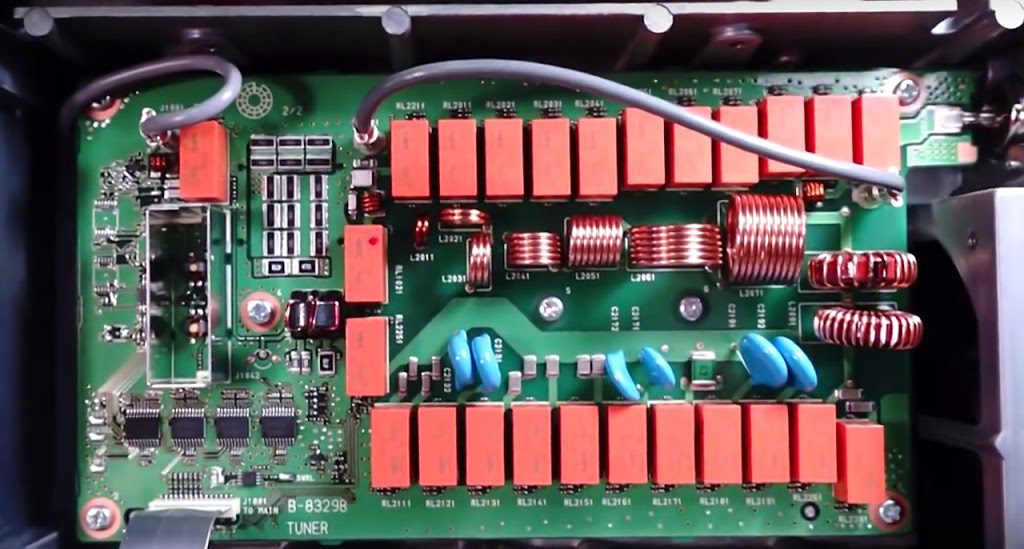
The IC-7300’s integrated tuner is also a novelty, being Icom’s first internal tuner that uses switched capacitors instead of variable ones (except the 10W one in the IC-703). The “emergency mode” allows it to match loads up to 10:1 SWR while reducing output power by half, wich could prove really useful in the field. It also probably the first tuner that works in the 70MHz band.
HANDS-ON
While using it, one of the first things that strikes you is how good it really sounds live. The noise reduction works properly and the solid aluminium chassis benefits the speaker very well. Of course, being all done in the digital domain it means you can adjust the audio response any way you like, but it really sounds very well without messing with the settings at all.
The other thing is the interface and it’s usability. It can do very much but it remains intuitive – you don’t really need to open the manual to understand this radio. SDR might sound scary and I know there is prejudice out the about how complicated or “artificial” a SDR radio feels (hey, my main radio runs on PowerSDR), but Icom really tried to keep this radio as legacy as possible. They even kept outdated concepts that users are familiar with, such as PBT filters or RF gain, they call the 36kHz clocked digital stream of audio data an “IF” and the architecture a “Direct Sampling Superheterodyne”. Of course, once you understand what SDR is, all of that will sound like total nonsense, but I think it’s cute how they tried to not scare people away.
PRICING
When Icom announced the official price for Japan, it was 139,800 yen+tax, wich at the time was equal to 1134 USD+tax or 1047 EUR+tax. The Japan market got it early and the street price dropped well below 130,000 yen. Recently it has been listed in North America for 1500 USD and in Europe for 1400 EUR / 1050 GBP, with availability at the end of March 2016. First batches are expected to fly out the door to people who have preordered it, wich will probably keep the price high for some time. If you’re looking to get one now, you should probably order from large shops such as Ham Radio Outlet (USA), Wimo (Germany) or ML&S (UK) sice there’s a greater chance of them having access earlier and to larger batches. Lowest listed price outside Japan seems to be LCCOM (Romania) for 5900 RON incl tax, wich is 1473 USD / 1320 EUR / 1025 GBP. Japan, North America and Europe versions are different, main difference being only the Europe version has the 70MHz band.
CONCLUSION
Radio amateurs are supposed to be driven by technical curiosity and openness to new technologies. It is sad that it took 15+ years for the first of the 3 big japanese equipment manufacturers to adopt a new technology, and the fact that the IC-7300 has to have those legacy features and outdated names just to make SDR more friendly doesn’t help, not one bit.
Yes, the Icom IC-7300 is very late to the SDR party, but at least it arrived in style and dresssed properly. SDR transceivers so far required a steep learning curve and that kept them away from becoming mainstream, although the benefits were obvious once you got accustomed to the interfaces. Well, the IC-7300 is the bridge that connects those two worlds somehow, since it will force both established SDR manufacturers to get busy designing standalone equipment and the other japanese manufacturers to update their technology. It is truly a very important product in the history of amateur radio.
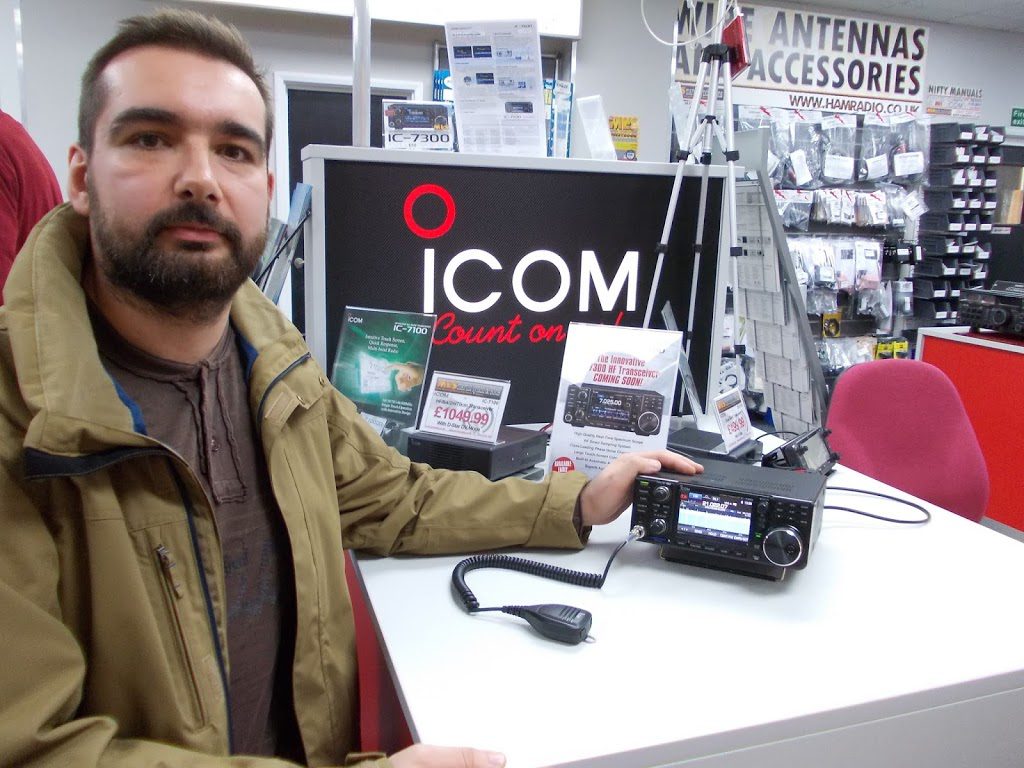
F.A.Q.
Can it be my main transceiver ? Sure it can, the feature set is that of a proper modern main station radio.
Can it be a contest radio ? Receiver performance is top class, filters are perfect and they claim effective cooling. So, yes.
Can I use it as a field radio ? It’s compact, weights a little over 4Kg, has a great internal tuner and takes just 900mA in standby. The touchseen might not work properly with wet/dirty hands, but other than that I would say it’s been buit for that.
Can it do digimodes ? It has RTTY decoder and can store macros, plus the nice USB connection allows any digimode software to be used from the computer.

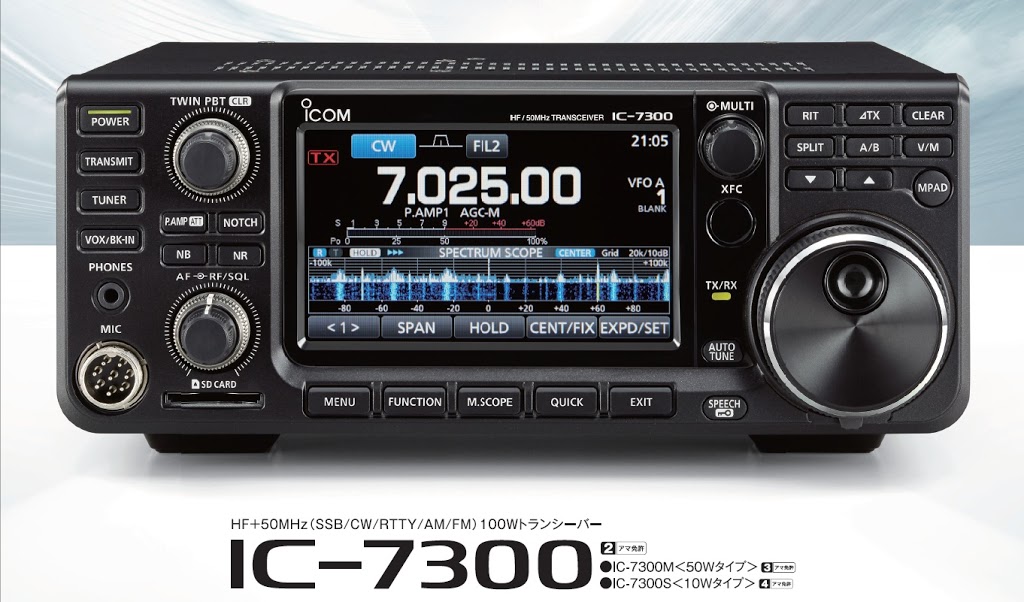

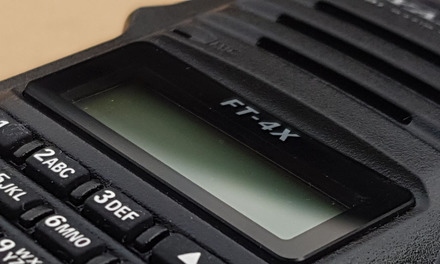
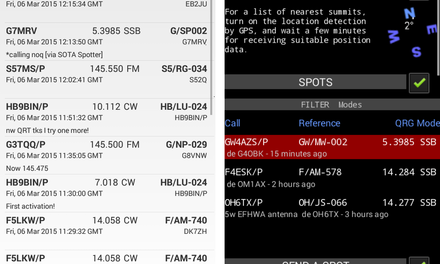
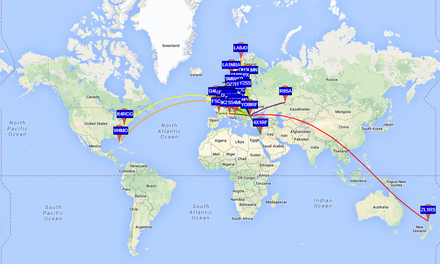
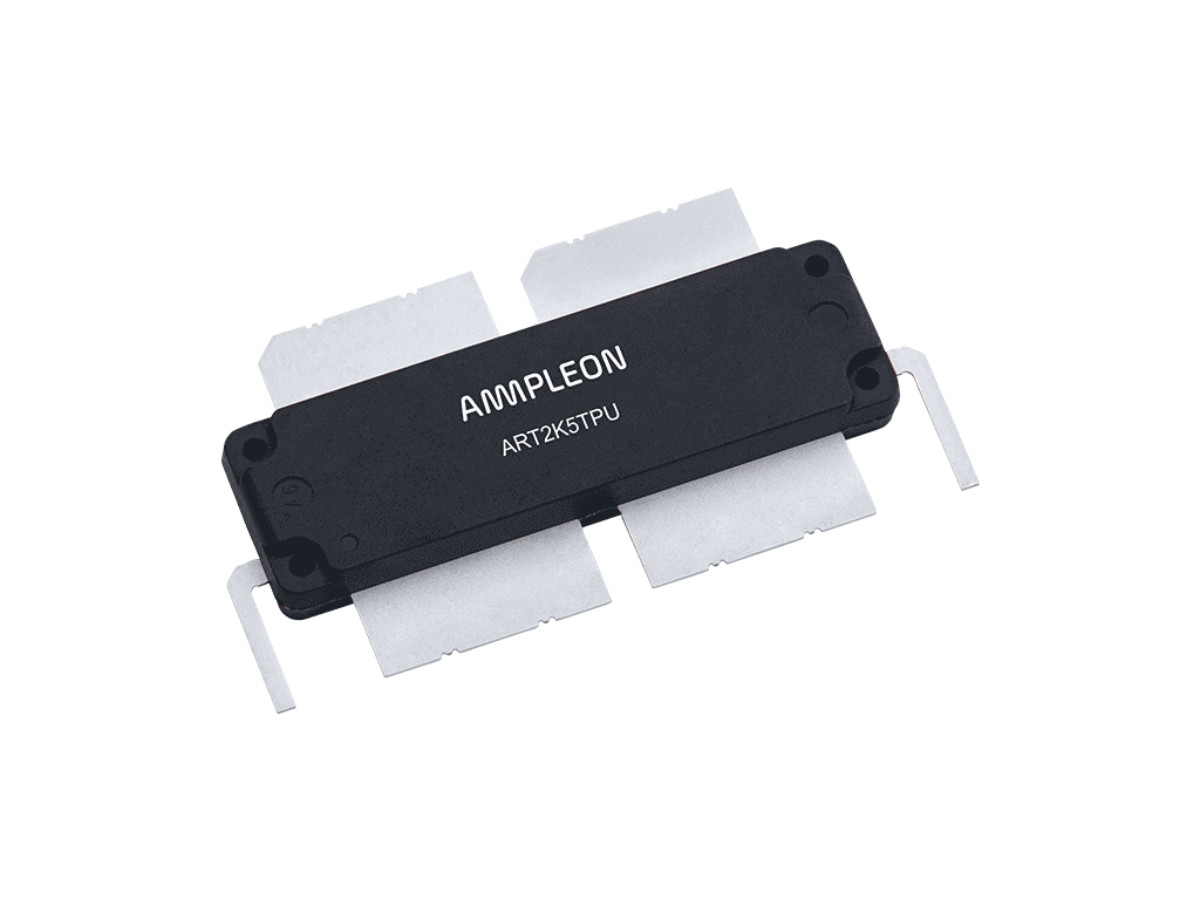
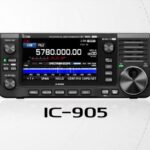
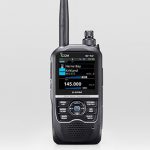
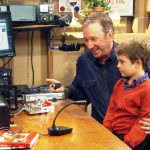
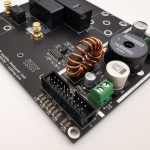
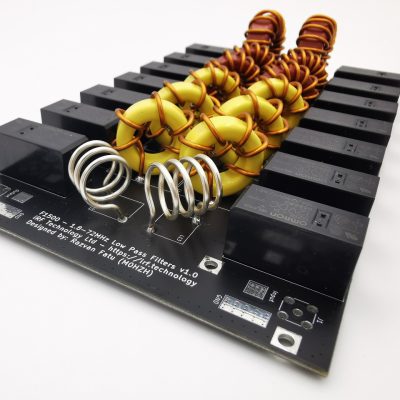
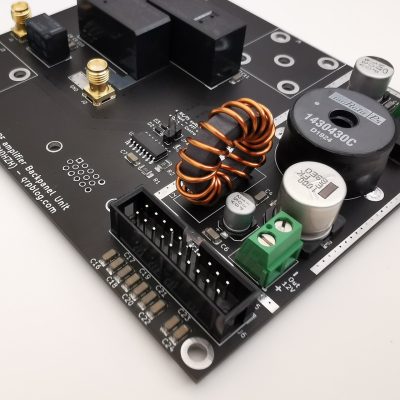
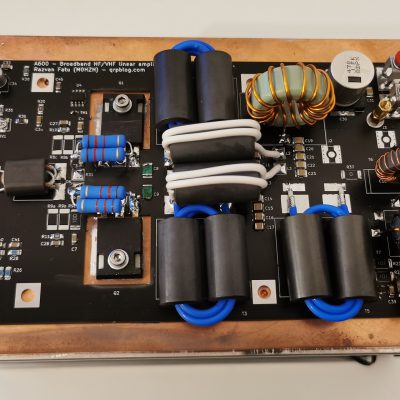
Thank you Razvan for your excellent review !
It's not the first internal ATU with fixed capacitors. IC-703 has one of these, better than most other internal ATU's although it's only designed to whitstand only 10W.
I will buy one the first day it is out here.
Nice review ,TNX for sharing . . .
73
I stand corrected and I've amended the text.
very good review
Great review, great job Razvan. It is exactly what everyone was eagerly waiting for. 73 and good DX de HA7WX Chris
Excellent review !
Could be my next purchase !
2 questions :
– future updates of the software ?
– use of WSJT-X to use JT65 ?
Many thanks,
Thierry – F5LHF.
Thank you all !
@Thierry: Icom already released a new version of RS-BA1 (v1.92) that fully supports the Icom IC-7300. If you meant firmware updates, they can be done by copying them on the SD card, and Icom will be working on them – especially since they will get alot of feedback for this radio. WSJT-X will work just fine, the IC-7300 has an internal sound card which is available via the USB cable.
Regards,
Razvan YO9IRF / M0HZH
Outstanding review. Thanks and 73 de John ke4kto
What is always important for me, does it have temperature controlled low noise fan?
Thanks for info, Paul.
A most interesting and excellent review. Thank you.
Good review.
One thing I miss: only one antenna connector won't work well with such a wide range of frequencies available. Two is an absolute minimum.
73 de Bram PC7B
Thank you for this useful review. I shall wait until the bugs are sorted and the price drops.
This comment has been removed by the author.
Thank you for the nice review. I am hopeful the USB connection with AF/IF can be used with HDSDR. There are some exciting possibilities with this rig.
A lot of hype and not a lot of substance. 14bit ADC is very noisy and the dynamic range is marginal. The horizontal scale of the spectrum analyzer is too small to be useful and the waterfall reminds my of puffy clouds.
It does not use I_Q signals and therefore is not an SDR.
The price of the unit is also an indicator for where it is in the performance scale…
Our test,
http://tonkojursky.blogspot.hr/2016/04/icom-ic-7300-test.html
Could you address the overload issue which has been reported by some in a future review?
My first entry into SDR is the SDRPlay (still waiting for it to arrive), I've been chomping at the bit for the 7300 and AES has some in stock so ordering one of those as well. This will supplant my Yaesu Mark V and Icom 746Pro nicely I think.
Great review!
Erik
Good choice you made with getting the RSP from SDRPlay. It's a great SDR
I currently run an Icom 7600. Is the 7300 a suitable replacement for the 7600 for DX'ing, in your opinion?
This comment has been removed by the author.
Hi Gary,
I don't think it's necessarily an upgrade. It is better in some aspects but it's aimed at a lower price band, so you might miss some of the features and extra front panel buttons the 7600 has. Best bet would be to try it out in a store or at a friend and see how you like the human-machine interface.
Cheers,
Razvan.
Did you make a comparisonIC 7300 VS icom ic-756 pro3??WHICH ONE DO YOU PREFER??CHEERS 73' DE SV1PDZ
Hi Alex,
From your comments, it sounds like maybe you have not owned one. Just to get this out of the way, it is most definitely an SDR, and a very good one for the price point in many folks opinion. Please see http://www.ab4oj.com/icom/ic7300/images/rx_tx_blk.jpg for a block diagram.
The consensus is that the 14-bit ADC is a non-issue:
"The performance difference between the 14bit and 16bit versions is not that large, ~1-2dB worse noise and dynamic range in the datasheet"
It's highly doubtful a person would know the difference without using test equipment.
In fact, my impression is that the 7300 has better receive than my 7600, and Sherwood's receiver tests seems to back that up, as it made 12th place in his list.
http://www.sherweng.com/table.html
On other fronts, the audio scope goes out to 4K, which is plenty unless you want to analyze overly-wide ESSB signals or AM. Yes, the 7300 has limits in some areas.
And as for the waterfall, if seeing a 1MHz swath of band at once is not enough, then I'm not sure what you are expecting of this radio. And, when I zoom in by reducing the span to 5K or 10K, the waterfall shows nearly the same level of signal detail as what I see on my Flex, so I'm not sure what the gripe is there.
I feel that the folks who have said negative things about the 7300 tend to fall into three categories:
1) Folks have never tried the rig for themselves and find it hard to believe all the glowing reports from 7300 owners.
2) Folks who are expecting a $1500 rig to beat out one that costs many times the price.
3) Flex/Anan owners who are a bit jealous of the performance and low price-point. I get it. It feels good to be a member of an exclusive group of SDR users, and a rig like this could be a bit threatening to that exclusivity in some ways.
(Disclaimer: I'm a Flex owner myself, and while it's certainly superior to the 7300 in many ways, I now prefer using the 7300 as my main radio.)
That's just my opinion, and you are certainly entitled to yours, so don't take this post as a personal attack, please. 🙂
Eric W1JH